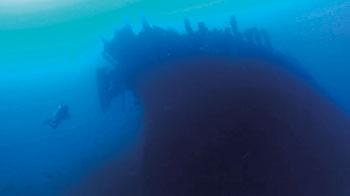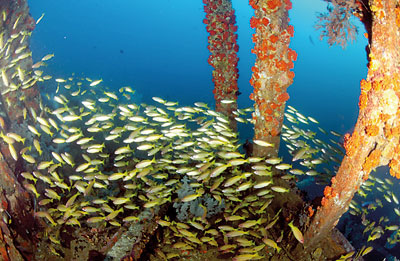Recently the world commemorated the 100th anniversary of the sinking of the Titanic. Five years after the Titanic disaster in 1917, a British armed merchant ship met its end in the Indian Ocean near Sri Lanka. The SS Worcestershire was en route from Rangoon to London when it was sunk by sea mines laid by German armed merchant raider SMS Wolf that was hunting British ships in the Indian Ocean at the height of World War 1. Two members of the crew died as the SS Worcestershire sank to its watery grave.
Nishan Perera, Naren Gunasekara, and Dharshana Jayawardena, three young divers have been on the trail of this lost ship for some years and recently were able to ascertain the identity of the wreck of SS Worcestershire. “We have located this ship about 12 km west of Mount Lavinia. The ship is massive -137 metres in length and 16.6 metres in width,” the divers told the Sunday Times.
 |
A ghost from the past: SS Worcestershire sank to its watery grave at the hands of German merchant/raider SMS Wolf. Pictures courtesy www.Dive Sri Lanka.com
|
Though local fishermen and occasional divers hunting for reef fish knew about a shipwreck in this locality, they had no clue that it was an important wreck sunk during World War I. “Finding the SS Worcestershire wasn’t easy. Maritime activities during World War 1 around Sri Lanka have not been well documented and we searched for two years,” said Dharshana. “We knew the approximate locality, and kept checking with local fishermen who can give us vital clues as they are used to fishing on wreck sites that are rich with fish.” Finally, one fisherman had shown them the location of an old ship and the trio wasted no time in diving for the wreck last April.
“As always, a first glimpse of a shipwreck is bone chilling and thrilling. As drowsiness due to the deep dive envelops your senses what seems to be a large and hazy shadow slowly develops details. Then, at 50 metres we are at the ship and in a strange, deep, lush paradise seen by a few,” Darshana said, recalling his first sight of the sunken ship. The ship was at a depth of 57 metres and largely broken up inside. Since it was not identified, the trio initially named the wreck B2633 – the name denoting its depth as measured in local dialect.
Based on the historical accounts and the size of the ship, the trio suspected it could be the SS Worcestershire. They found the stern bore had a strong resemblance to SS Worcestershire and the size of the ship too certainly matched. The size, guesstimates of tonnage and features in archival photos to wreck photos and the condition of the wreck in relation to the date of sinking considering the level of deterioration was used to ascertain the identity of the shipwreck. The width of the wreck (beam) is also a feature that is used to identify wrecks, so the divers were keen to check this on their next expedition.
The team made their second dive to the wreck in February this year –to take the vital measurements. The trio, experts in underwater photography captured the key features of the wreck and measured its width (beam) to compare it with the ship dimensions found in the archives.
They were ecstatic when they found the length of the beam matched that of the SS Worcestershire. They had solved the mystery of shipwreck B2633.
SS Worcestershire is not the only shipwreck this diving trio have been following. Another ship sunk by the mines laid by the same German battleship SMS Wolf in February 1917 is SS Perseus, a British armed merchant vessel. A massive shipwreck 15 km west of Colombo in deep waters they suspect could be this very ship. It lies over 40m deep and in close proximity to the last known location of the Perseus, say the divers. “We are certain that this is the Perseus based on location and also key features of the ship, size etc but will only be able to verify it after measuring the beam most probably next season,” says Darshana.
 |
| SS Perseus? Another World War 1 wreck |
They may be underwater but there is huge pressure from greedy businessmen to salvage these wrecks for their metal. But these sunken shipwrecks are our underwater treasures, maintains Nishan who says the presence of massive shoals of fish on the wrecks is quite amazing. “The wrecks off Sri Lanka’s west coast are also much sought after fishing grounds. Shipwrecks provide hiding places, food and breeding grounds for fish. So they are vital for fisheries too,” explains Nishan, who is a marine biologist reading for his PhD.
“The transformation of a shipwreck to an artificial coral reef is amazing. When a ship sinks it is just a jumble of metal and other man-made material. But as soon as it hits the sea bed, it starts becoming a coral reef,” he added, stressing that these wrecks around Sri Lanka should not be salvaged.
Three more shipwrecks in the oceans around Sri Lanka, they are investigating are the MV Tricolor – a Norwegian transport vessel sunk in 1931 off Beruwala, British Seargeant –a transport steam tanker sunk in 1942 off Batticaloa and SS Lady Macullum sunk near Trincomalee. Measuring the length, proximity to the last known location and size has helped them to identify British Sergeant.
Shipwrecks are also tourist attractions. The H.M.S Hermes, the first aircraft carrier sunk during World War II off Batticaloa was featured among the top 100 wrecks in the world by the UK Sports Diver Magazine and hundreds of dive enthusiasts visit Sri Lanka every month just to dive to this wreck. “Sri Lanka has not even tapped 1% of its marine tourism potential as it lacks understanding of the true value of its underwater wealth and revenue potential. It is time to tap this commercial potential as well,” says Naren. |



